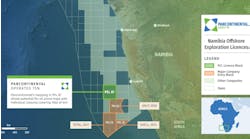Expandable tubulars enable multilaterals without compromise on hole size
Casing design in complex wells
Karl DeMong
Mark Swift
Halliburton Energy Services
Mark Rivenbark
Enventure Global Technology
Carl Dismuke
Saudi Aramco
The production and completion advan-tages of multilateral technology are well documented. As the technology has developed, more of the functionality of a conventional well has been added to the multilateral well. In addition, higher-level junc-tion types have developed a more significant drop in hole size through them.
After milling the window and drilling the lateral, the openhole drill liner is installed.
With the application of solid expandable tubulars, operators now have the opportunity to complete multilaterals without the need to compromise on hole size.
To date, one well of this type has been drilled, with many others in the planning stages. Solid expandable tubular technology is applicable in a variety of multilateral applications and in a wide range of casing sizes. Solid expandable tubulars make it possible to start the well smaller than normal without compromising the casing size at the multilateral junction, reducing well construction costs. With solid expandable tubulars, it may be possible to maintain the same casing size as the mother bore in the lateral, allowing a larger drain hole to be drilled into the pay zone of interest than might be possible with conventional casing string designs.
System development
Casing designs previously used in both typical and multilateral wells have no provision for preserving hole size, other than starting with ever-bigger strings of casing. Solid expandable tubulars, however, enable operators to start the well with smaller casing strings and conserve hole size when successive strings need to be set. Also, the anchor hanger joint, which replaces a conventional liner hanger, ensures a good seal at the liner lap, eliminating the possibility of a squeeze job.
With day rates running into the hundreds of thousands of dollars per day, operators appreciate this added level of certainty. For the solid expandable tubular system, an elastomer wrapped joint, (the anchor hanger) provides a feature that guarantees a proper seal at the liner lap. These joints are expanded and sealed as part of the normal process of expanding the casing. Additional trips are not required. This process is essentially the same for both conventional and multilateral wells.
The solid expandable tubular system – including casing, anchor hanger joint, and launcher assembly – is run as a single assembly. Once on depth, a dart is dropped while seal and pressure is applied down the drillstring. This creates a pressure chamber in the launcher assembly. In one trip, the casing is expanded from the bottom to the top and the liner is sealed back and hung off in the base casing.
The lateral hole section is drilled per the well program using conventional bits and mud motors.
The system is pressure tested and the shoe is drilled out. In the case of multilateral wells, the solid expandable tubulars can be run into the lateral hole sections using a whipstock deflection device.
System application
The construction of the junction and the installation of this equipment involve several critical steps. First, the milling assembly is aligned to the desired orientation on the rig floor. Next, it is run into the well in conjunction with a permanent production packer and a patented keyless latch mechanism to ensure correct depth and orientation. The third step involves milling the window and retrieving the milling assembly.
The milling assembly cuts a long, full-gauge window suitable for re-entry of the lateral and later deployment of the expandable liner. The latch coupling provides a positive means for locating the lateral for the life of the well, enabling easy access for future remedial operations.
The higher-level junction types developed have had a more significant drop in hole size through them.The fourth step involves installing a drilling whipstock, which is run with bolted mills, and dressing the window. With the bolt sheared, the window is milled to full gauge. Finally, the lateral hole section is drilled as per the well program, using conventional bits and mud motors.
If the near wellbore area is swept and the well requires repositioning in the revervoir, this size disadvantage becomes pronounced.
null
After milling the window and drilling the lateral, the expandable casing is combined with the expansion cone in the bottomhole assembly (BHA). The length of casing to be expanded is run in the hole and produced with conventional flush-joint connectors. Once the entire desired casing is run, a false floor is rigged.
Workstring
Using a safety sub, the workstring is run into the casing and screwed into the hollow expansion cone. After being picked up, together with the expandable casing, the casing rests on the expansion cone face. Because the workstring is attached to the expandable liner at the float shoe (which the expansion cone is splined into) the casing is pulled into the hole by the workstring, rather than pushed into the hole. This also happens when running conventional liners because the work string is attached at the top of the liner during conventional liner running jobs. Therefore, the liner is pushed to bottom.
When running an expandable liner, the liner is attached at the bottom and pulled into the hole with the work string. This configuration allows any required torque (while rotating the liner) on the bottom of the liner to facilitate getting the liner to bottom if it should stop going in the hole on its own.
Cement job
Once the expandable liner has reached TD, the cement is pumped similar to an inner-string cement job. Because the cone is splined into the float shoe, the liner can also be reciprocated to enhance the cement job. A latch-down dart is pumped and, when seated inside the float shoe, forms a pressure chamber. The pressure increases until a set of rupture discs, located in the top of the float shoe, rupture and allow the pressure to be applied to the backside of the expansion cone. Once the expansion pressure is reached, the casing is extruded off the face of the cone until it reaches TD.
The well is planned to be drilled with three lateral sections and placed within the top 10 ft TVD of the formation top.
null
The next process resembles blowing the end of a wrapper off of a soda straw. The difference in the expansion process is that the casing is extruded over the cone as it is being blown off of the workstring. Generally, 5,000 to 10,000 lb is maintained on the bit. This weight allows the BHA to remain positioned at TD while the rig blocks hold up the rest of the workstring weight. As the workstring is pumped out of the hole, the pressure is released before each stand of drillpipe is unscrewed and set back.
The workstring is re-pressurized and the expansion process continues with the expansion of the casing through soft, retarded cement, until the entire liner is expanded. Typical liner expansion takes approximately 14 min per stand.
The expandable liner is assembled with an expandable anchor hanger joint as an integral system top. Once the anchor hanger is expanded, the cone exits the liner assembly completing the expansion process. Any excess cement is reversed out, and the liner is positively pressure tested. The aluminum float shoe is milled out. The shoe can be tested allowing the next hole section to be drilled.
The majority of the wells in the Middle East region are completed with 7-in. liner or casing set into the pay zone. This liner size gives enough diameter for a wide variety of initial completion options and cased hole workover options. The re-entry drilling options are very limited, however. If the near wellbore area is swept and the well requires repositioning in the reservoir, the size disadvantage becomes prominent.
Case study
A case study from the Arabian Gulf illustrates the advantages of the combination of multilateral technology and expandable tubulars. The field consists of a large dome structure with a total of eight productive reservoirs. The majority of the production comes from two reservoirs, the Hanifa and Hadriya. The field is mature and has been on production for more than three decades. A peripheral waterflood was instituted four years after the start of production.
The main reservoirs in the field consist of Middle to Late Jurassic carbonate grainstones. Both the Hanifa and Hadriya reservoirs have permeable intervals inter-bedded with low permeability layers. This inter-bedding has resulted in bypassing large amounts of oil downstructure in the two reservoirs:
- Hanifa reservoir – injected water preferentially cross-flows into the deeper, higher-permeability intervals. The water flows up-structure, resulting in bypassing oil in the upper most layers of the reservoir at downstructure locations
- Hadriya reservoir – injected water preferentially flows in the high-permeability upper layers, resulting in bypassing oil in the middle and lower sections of the reservoir at down-structure locations.
Berri field history
The Berri field was developed using vertical wells located at mostly crestal locations in the field. As wells began to produce water, they were plugged back to eliminate water production. Earlier wells were drilled using a 9 5/8-in. production casing, but as remedial water shut off operations commenced, 7 and/or 4 1/2-in. liners were used to isolate water productive intervals.
Additional wells were drilled over time to maintain target rates using mainly 7-in. production casing. Between 1990 and 1993, the first horizontal wells were drilled to target the down-structure by-passed oil zones in the Hanifa and Hadriya reservoirs. These wells proved to be successful in recovering oil left behind the flood-front. However, 7-in. production casings were usually used to improve drilling costs of the horizontal drilling program. Presently, nearly every production well in the Berri field has 7-in. or smaller casing.
Due to the smaller sizes of production casing, few remedial operations designed to target these by-passed areas are capable of delivering the desired production rates. Drilling new wells was seen as the optimal alternative and programmed into business plans.
Expandables with multilaterals
The use of solid expandable tubular technology changed the way we look at the development strategy for the Berri field. Using expandable tubulars and multilateral drilling technology allows the feasibility to be evaluated in existing wells that are currently unproductive. Most of the dead wells were nonproductive due to high water cut and lacked conventional plugback or water shut-off opportunities. The evaluation centered on redrilling wells to bottomhole targets that would otherwise require drilling a new well.
Due to the smaller casing size already in the majority of existing wells, solid expandable tubulars were chosen as the optimal means for retaining hole size. Upon review of available candidate wells, a suitable producer was identified that would target locations where future drilling was planned.
The workover objective is to sidetrack an existing well as a maximum reservoir exposure (MRE) producer to increase well productivities in the northern bypassed area of the Berri Hanifa reservoir. Based on production logging from offset wells, the bypassed oil zone contains approximately 50 ft true vertical depths (TVD) of remaining oil at the top of the Hanifa reservoir.
The well is designed to replace two future producers. It is to be drilled with three lateral sections placed within the top 10 ft TVD of the formation. To control the performance of each lateral section, plans are to use surface-activated downhole flow control devices that will enable the operator to produce and test each lateral leg separately.
The importance of this technology can be described in terms of potential savings. If the plan is to redrill an existing well, savings would be achieved by not requiring new facilities or drillsites/platforms. In addition, two production wells are saved with the multilateral technology, which allows for targeted multiple locations within the bypassed area to exist.
Plans
The operator is confident with the success of the first planned well and is planning additional wells in the same field. This design will allow for a larger and longer lateral section(s) with corresponding improvements in directional control. Additionally, the inclusion of a Smartwell will allow for independent remote control of each leg of the multilateral well. The success of this project may result in a major decrease in field development costs going forward with the reduction or elimination of additional planned wells and/or platforms.
Plans are being studied to deploy expandable casing to cover window junctions where the lateral leg has watered out. This application will cure the water ingress with virtually no loss of inside diameter through the motherbore. Additionally, expandable casing is being proposed to clad over existing casings that are deteriorating due to contact with corrosive water aquifers.








